Researchers release hundreds of endangered toads in Wyoming
by MEAD GRUVER, Associated Press
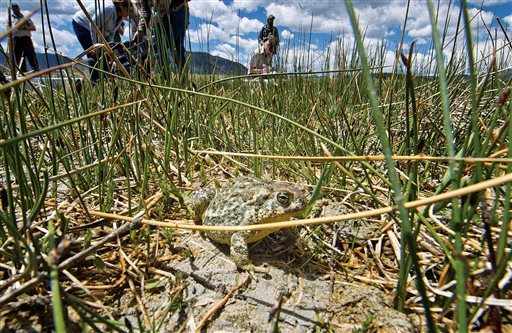
|
| A toad sits at the Buford Foundation Ranch, one of three locations volunteers and members of the U.S. Fish and Wildlife Service gathered at on Wednesday, June 1, 2016, to release adult Wyoming toads from the Saratoga National Fish Hatchery as part of the 2014 Cooperative Recovery Initiative project, near Laramie, Wyo. Wildlife officials are releasing more than 900 toads in Wyoming, saying they could help researchers find ways for the endangered species and other amphibians to resist a devastating fungus. (Jeremy Martin/Laramie Daily Boomerang via AP) |
CHEYENNE, Wyo. (AP) — The release of more than 900 Wyoming toads in a valley Wednesday could lay the groundwork for helping the critically endangered species and other amphibians resist a devastating fungus, researchers say.
Researchers usually release Wyoming toads in the wild as tadpoles. The release of hundreds of fully grown captive-bred toads is a new tactic as scientists seek ways to counter chytrid fungus.
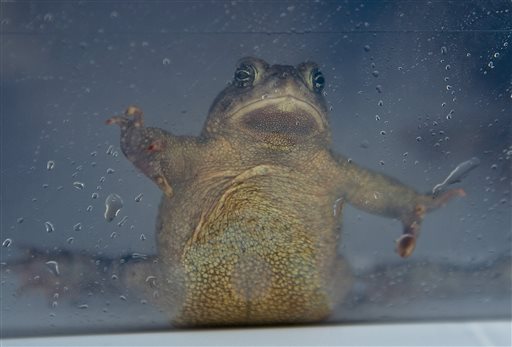
|
| An adult Wyoming toad holds itself up in a plastic bin on before being released at the Buford Foundation Ranch as part of the U.S. Fish and Wildlife and Saratoga National Fish Hatchery's Cooperative Recovery Initiative project, Wednesday, June 1, 2016, in Laramie, Wyo. Wildlife officials are releasing more than 900 toads in Wyoming, saying they could help researchers find ways for the endangered species and other amphibians to resist a devastating fungus. (Jeremy Martin/Laramie Daily Boomerang via AP) |
Chytrid has devastated hundreds of amphibian species worldwide since its discovery in the late 1990s. Some call chytrid the worst known infectious disease because it imperils so many species.
"Since chytrid fungus cannot be eradicated in the environment, our hope is that these adult animals will have a stronger immune system and be more resilient against chytrid in the wild than their younger counterparts," said Lizzy Mack, a U.S. Fish and Wildlife Service scientist who specializes in the Wyoming toad.
Biologists hope to test their theory when they return to Mortenson Lake National Wildlife Refuge and two other reintroduction sites in the years ahead. Each released toad carries a tiny electronic identification tag under its lumpy skin.
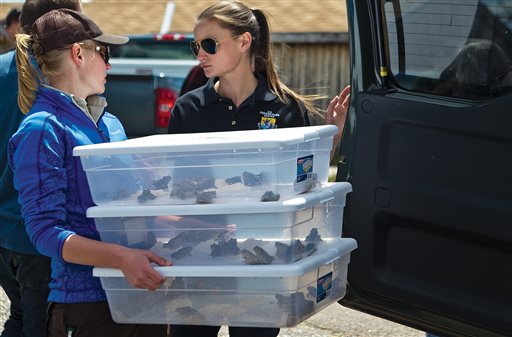
|
| Ana Bode with the Leadville National Fish Hatchery and Lizzy Mack with U.S. Fish and Willife Service load bins of Wyoming Toads into the back of a vehicle Wednesday, June 1, 2016, to be taken to Fred and Stephanie Lindzey's property to be released, near Laramie, Wyo. The Lindzeys have a safe harbor agreement with U.S. Fish and Wildlife enables them to have endangered Wyoming toads released on their property. Wildlife officials are releasing more than 900 toads in Wyoming, saying they could help researchers find ways for the endangered species and other amphibians to resist a devastating fungus. (Jeremy Martin/Laramie Daily Boomerang via AP) |
The research should prove valuable for the handful of other captive breeding programs for imperiled amphibians, Mack said.
The Wyoming toad is a critically endangered species never known to have existed outside southeast Wyoming's Laramie Valley. The brown-and-green hoppers aren't exactly a majestic sight to behold — a big one measures only a couple inches.
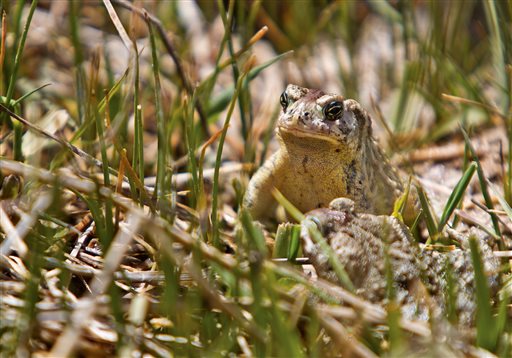
|
| A pair of adult Wyoming toads make their way through a wetland area Wednesday, June 1, 2016, after being released at the Buford Foundation Ranch as part of the U.S. Fish and Wildlife and Saratoga National Fish Hatchery's Cooperative Recovery Initiative project, near Laramie, Wyo. Wildlife officials are releasing more than 900 toads in Wyoming, saying they could help researchers find ways for the endangered species and other amphibians to resist a devastating fungus. |
The toads were common until their numbers crashed in the 1970s; they were declared extinct in the wild in 1991. Scientists suspect the loss of habitat — irrigation projects that diverted water from ponds and streams in the high-elevation, wind-swept valley — played a major role in the toads' decline.
For years, few if any captive-bred tadpoles would survive a year after release.
Researchers then hit upon the idea to temporarily keep tadpoles in cages partially submerged in ponds. The cages kept predators away, giving the tadpoles time to get used to their natural environment and grow up some before being released to totally fend for themselves.
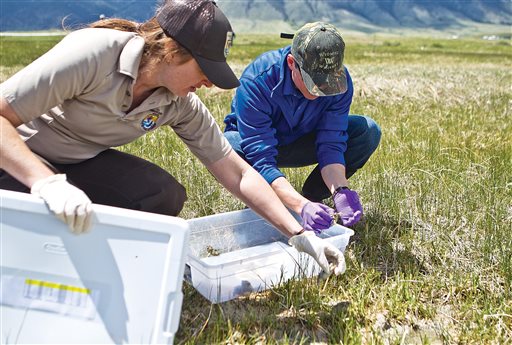
|
| Heidi Meador with the Saratoga National Fish Hatchery and Doug Keinath with the U.S. Fish and Wildlife Environmental Service Office release adult Wyoming toads Wednesday, June 1, 2016, in a wetland at the Buford Foundation Ranch, near Laramie, Wyo. Wildlife officials are releasing more than 900 toads in Wyoming, saying they could help researchers find ways for the endangered species and other amphibians to resist a devastating fungus. (Jeremy Martin/Laramie Daily Boomerang via AP) |
Scientists credit the technique with re-establishing a year-round population of hundreds of Wyoming toads. A new federal recovery plan for the toads envisions five self-sustaining populations that could enable the toad's removal from endangered species protection as soon as 2030.
Copyright 2016 The Associated Press. All rights reserved.
This material may not be published, broadcast, rewritten or redistributed.
Page created on 6/3/2016 3:21:59 AM
Last edited 6/3/2016 3:21:59 AM
The beliefs, viewpoints and opinions expressed in this hero submission on the website are those of the author and do not necessarily reflect the beliefs, viewpoints and opinions of The MY HERO Project and its staff.






